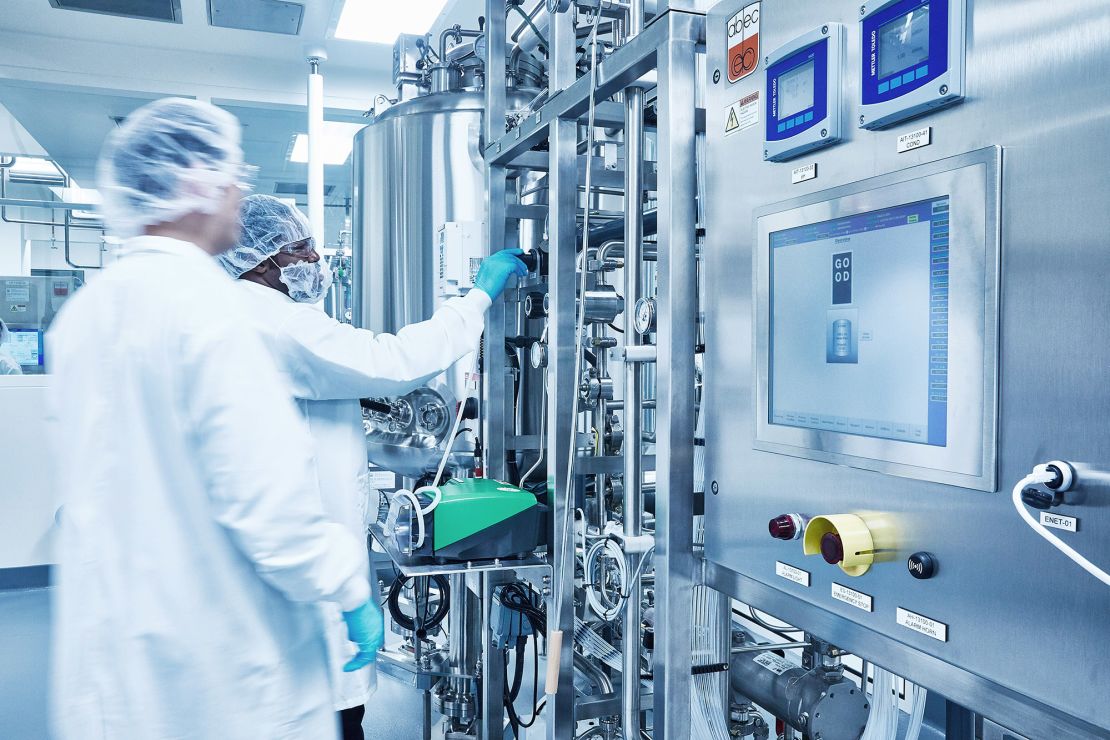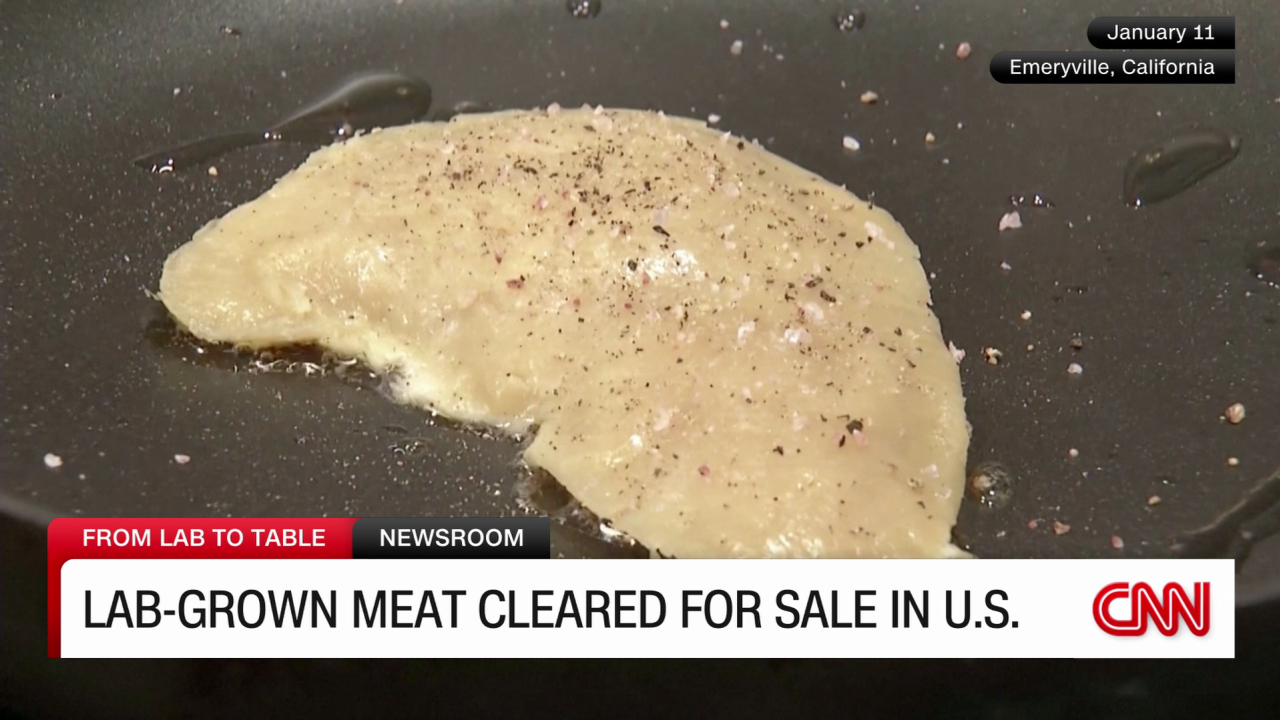Soon, Americans are going to be able to try chicken that comes directly from chicken cells rather than, well, a chicken.
On Wednesday, the USDA gave Upside Foods and Good Meat the green light to start producing and selling their lab-grown, or cultivated, chicken products in the United States.
Don’t run to the supermarket just yet, though. It’s going to be a while before you can buy cell-based meat in stores, though you should be able to get a taste at a restaurant sooner.
Here’s everything you need to know about lab-grown meat.
What is it?
In a nutshell, lab-grown meat — or cultivated or cell-based meat — is meat that is developed from animal cells and grown, with the help of nutrients like amino acids, in massive bioreactors.
This happens in a production facility that looks a lot like a brewery: When you picture it, don’t think of people in white coats and hairnets peering through microscopes into petri dishes, but instead people in white coats and hairnets wandering between giant vats.

When the meat is ready, companies collect it from the bioreactors and move it along the processing line.
Good Meat’s protein “looks a lot like a minced chicken,” when extracted, said Andrew Noyes, head of global communications and public affairs at Good Meat parent company Eat Just.
What’s so great about that?
For one thing, growing meat from cells means that people can eat meat without having to slaughter animals.
Upside Foods explains that cells it gathers from a fertilized chicken egg are stored in its cell bank and can be used for at least ten years. Animal cells can come from animal biopsies or even feathers, among other sources, Noyes said.
There are environmental considerations, as well. Agriculture, particularly animal agriculture, is responsible for a significant amount of greenhouse gas emissions, which contribute to climate change. Overhauling that system could ease the burden on the planet.

To make cultivated meat, “energy use needs are high,” said Bruce Friedrich, president and founder of the Good Food Institute, a nonprofit group that promotes alternative proteins. Still, those energy needs will be offset by the reduction in land and water use and other benefits, he said, adding that “renewable energy is how we reap the maximum climate benefit.”
If cultured meat is produced at scale, it could also offer a solution to feeding the world’s growing population.
Is it vegetarian?
No. Unlike plant-based meats like the products made by Impossible Foods and Beyond Meat (BYND), cultivated meat uses animal cells and so is not considered vegetarian.
Because cultivated meat comes from cells, rather than animals with intestines, they’re not exposed to the type of contaminants that can plague traditionally harvested meat, noted Friedrich. That means that cultivated meat should be free of E. coli and salmonella, he said.
Meat eaters who are concerned about those types of risks might prefer cultivated meat. But diners who are trying to reduce meat consumption altogether won’t find a solution here.
So does it taste like regular meat?
Basically, yes.
That’s according to former CNN reporter Julia Horowitz, who tried a cell-based meatball made by Ivy Farm Technologies, a British company.
In her words, the meatball was “a bit dense and on the smaller side — not exactly the classic version you imagine melting in your mouth at an Italian restaurant.” But, she noted, it tasted like traditional meat, and the flavor was “full and savory.”
A CNET reporter who tried Upside Foods’ cultivated chicken said “this actually does” taste like chicken. Others who have tried Good Meat’s cultivated chicken, which was approved for sale in Singapore in 2020, had a similar reaction.
What has been approved in the US?
On Wednesday, the USDA’s Food Safety and Inspection Service approved Upside Foods’ and Good Meat’s applications for a “grant of inspection.” Those types of applications “are approved following a rigorous process, which includes assessing a firm’s food safety system,” according to an FSIS spokesperson.
The nascent cultivated meat industry is regulated by both the USDA and the FDA.

Over the past several months, the agencies have been approving the products step-by-step: In November, the FDA issued a “no questions” letter to Upside Foods, essentially saying that it had no further questions about the safety of the product, and so considers it safe for consumption. Good Meat got a similar letter in March. Then, in June, both companies got USDA approval for their labels.
That doesn’t mean the floodgates are necessarily opened for all types of cultivated meat.
“We would need to go through another regulatory process for beef, pork, [or] any other kind of animal protein,” Noyes said, noting that Good Meat is in the early stages of developing cultivated beef.
When will I be able to try it?
Soon! Well, soon-ish, and only if you’re in certain areas.
Neither Upside Foods nor Good Meat have given a date for when their products will be available, but they each have a plan in place to get products out to the public, and Good Meat said Wednesday that production started immediately.
Good Meat previously announced a partnership with chef and restaurateur José Andrés to bring the item to a Washington, DC, restaurant, and is working with his team on a launch at China Chilcano. As production ramps up, Good Meat may consider partnering with other restaurants or launching in retail. But a supermarket launch is way down the line, Noyes said.
Upside Foods is planning to introduce its product at Bar Crenn, a San Francisco restaurant, but did not share a launch date yet. Selling at Bar Crenn should help Upside Foods learn more about how chefs and diners feel about the product, a representative said. Eventually, the company plans to work with other restaurants and make its products available in supermarkets.
For now, Upside Foods is holding a contest to allow curious customers to be among the first to try the product in the US.
How much does it cost to make?
A lot.
It cost over $300,000 to develop the first lab-grown burger, which was served a decade ago. The British company Ivy Farm said last year that it could produce a similar product for less than $50, CNN previously reported. That’s a radical improvement, but it’s still way more than a traditional burger costs (and imagine the markup!).
Noyes didn’t share specific numbers, but noted that “getting to price parity for us, from a cost of goods standpoint and cost of production standpoint, is a major challenge.” He added that the company has a “path to get there.”
It will be expensive to build out the facilities that will allow for economies of scale, noted Matthew Walker, managing director for food and agriculture at S2G Ventures, a mission-driven private capital group.
“The challenge is really about showing not only, can you produce product at a certain price per pound that will be palatable to a certain portion of the consumer base … but can you demonstrate the appropriate return profile on assets?” said Walker.
Companies will also have to prove that they “have a scalable, repeatable model,” he noted.
How much will it cost for me?
Unclear — but it seems like this first offering won’t be all that expensive, despite the high costs of production.
Good Meat’s cultivated chicken will be priced at a slight premium or comparable to other chicken items at a José Andrés restaurant, Noyes said.
“To be clear, our company is not making money on these sales, we’re taking a loss,” Noyes said. “At this stage … we want to get it out there. We want people to taste it, we want people to experience it, we want people to tell their friends and family about it.”
Ultimately, Good Meat and Upside Foods both want to sell products to consumers for the same price as traditional chicken, or cheaper. Upside Foods said that it is not disclosing its cost of production, but noted that its product will be sold at a premium compared to traditional chicken.
— CNN’s Kristen Rogers contributed to this report.






















